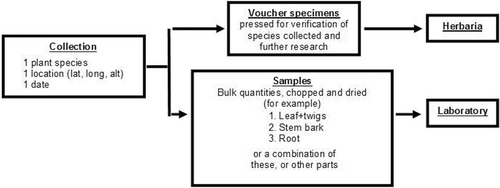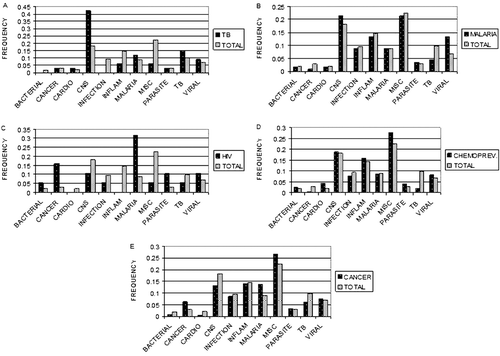Figures & data
Table 1. Accessions in the Vietnam-Laos ICBG project. Includes collections (unit of 1 species collected at one locality on one date), samples (plant parts, often more than one per collection), medicinal uses (unit of 1 use recorded for 1 species in 1 interview) and bioassay results (unit of 1 bioassay test on one sample).
Figure 1. Graphic representation of the difference between collections and samples. A collection is a single individual plant collected on a certain date in one locality. For every collection, two plant materials are gathered: (A) voucher herbarium specimens; (B) one or more bulk samples each composed of selected plant parts. The two types of plant materials are linked by a common tracking number.

Table 2. Contingency table, hit rate and statistical analysis for plant collections analyzed for antimycobacterial assay (MABA-H37RA). Statistical analysis refers to contingency table.
Table 3. Hit rates for collections and for samples, all random vs. all ethnomedical. Active designation based on highest level of qualitative result (A>Q>I) for any test result pertaining to accession.
Table 4. Hit rate for collections, sorted by rationale and country, for all five bioassay systems. Active designation based on the best qualitative results (A>Q>I) for any test result pertaining to collection.
Table 5. Hit rate for samples, sorted by rationale and country, for all 5 bioassay systems. Active designation based on the best qualitative results (A>Q>I) for any test result pertaining to sample.
Table 6. Hit rate for samples, sorted by rationale and country, for individual bioassay systems. Active designation based on the best qualitative results (A>Q>I) for any test result pertaining to sample.
Table 7. Hit rate for collections, sorted by specific vs. other ethnomedical use, for all 5 bioassay systems (all bioassays included for malaria, chemoprevention and cancer treatment). Active designation based on the best qualitative results (A>Q>I) for any test result pertaining to collection.

